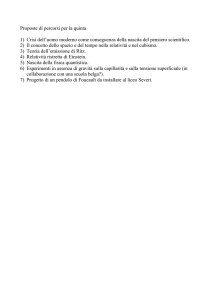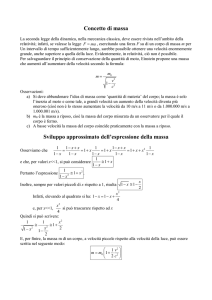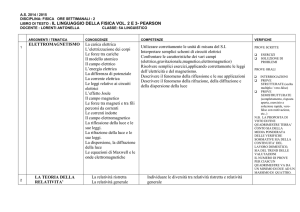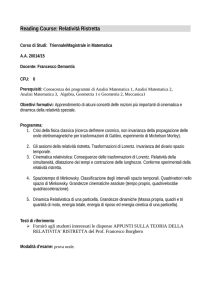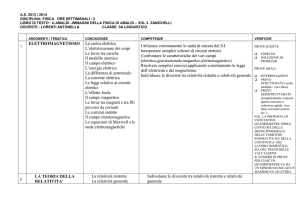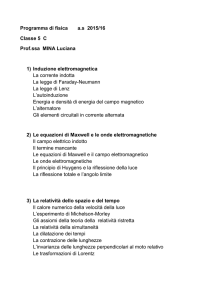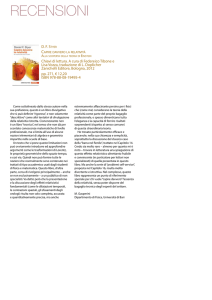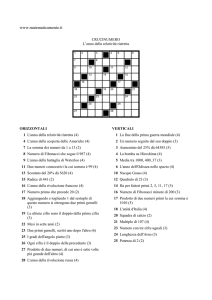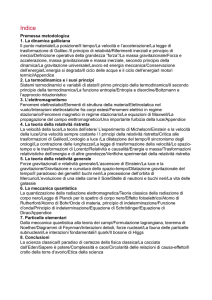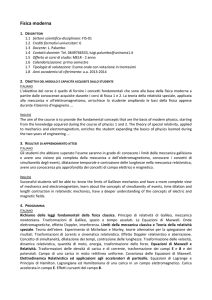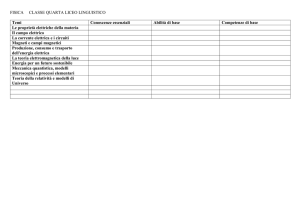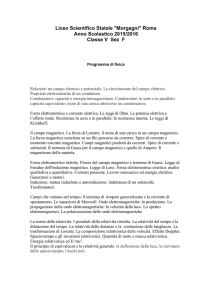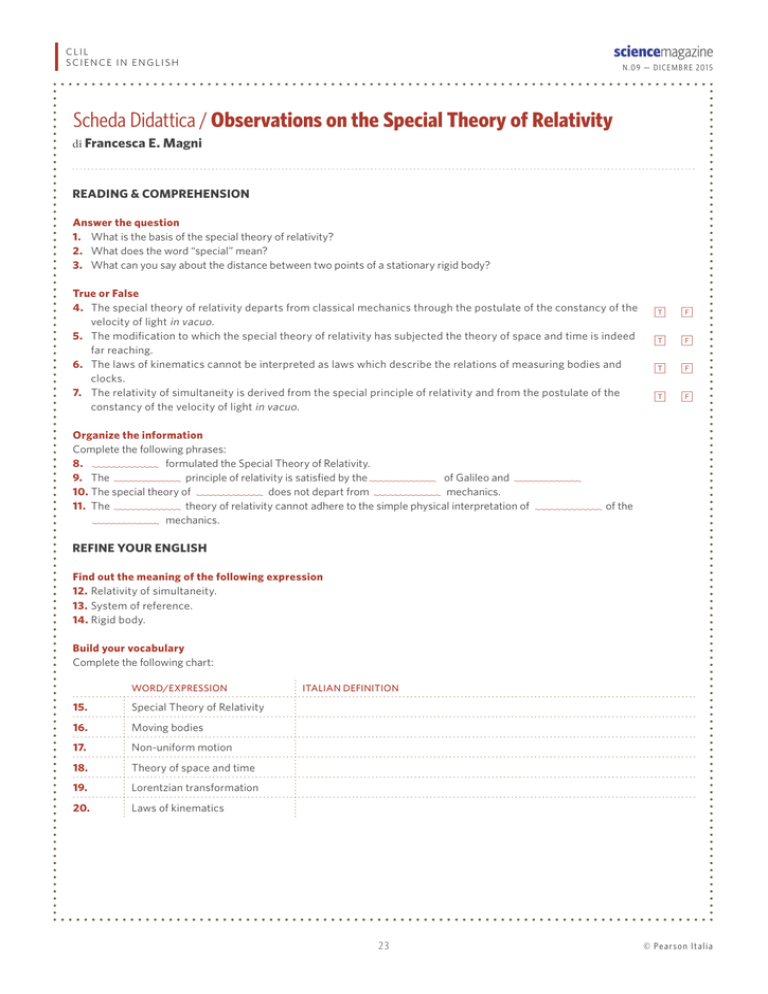
CLIL
SCIENCE IN ENGLISH
N.09 — DICEMBRE 2015
Scheda Didattica / Observations on the Special Theory of Relativity
di Francesca E. Magni
READING & COMPREHENSION
Answer the question
1. What is the basis of the special theory of relativity?
2. What does the word “special” mean?
3. What can you say about the distance between two points of a stationary rigid body?
True or False
4. The special theory of relativity departs from classical mechanics through the postulate of the constancy of the
velocity of light in vacuo.
5. The modification to which the special theory of relativity has subjected the theory of space and time is indeed
far reaching.
6. The laws of kinematics cannot be interpreted as laws which describe the relations of measuring bodies and
clocks.
7. The relativity of simultaneity is derived from the special principle of relativity and from the postulate of the
constancy of the velocity of light in vacuo.
Organize the information
Complete the following phrases:
8.
formulated the Special Theory of Relativity.
9. The
principle of relativity is satisfied by the
of Galileo and
10. The special theory of
does not depart from
mechanics.
11. The
theory of relativity cannot adhere to the simple physical interpretation of
mechanics.
T
f
T
f
T
f
T
f
of the
REFINE YOUR ENGLISH
Find out the meaning of the following expression
12. Relativity of simultaneity.
13. System of reference.
14. Rigid body.
Build your vocabulary
Complete the following chart:
WORD/EXPRESSION
15.
Special Theory of Relativity
16.
Moving bodies
17.
Non-uniform motion
18.
Theory of space and time
19.
Lorentzian transformation
20.
Laws of kinematics
ITALIAN DEFINITION
23
© Pearson Italia
CLIL
SCIENCE IN ENGLISH
N.09 — DICEMBRE 2015
» Scheda Didattica / Observations on the Special Theory of Relativity
TRADUZIONE
postulato della relatività ristretta, seguono, nel modo ben noto,
la relatività della simultaneità, la trasformazione di Lorentz, e
le leggi connesse sul comportamento dei corpi rigidi e degli
orologi in movimento.
La modificazione alla quale la teoria della relatività ristretta ha
assoggettato la concezione dello spazio e del tempo è invero
di vasta portata, ma un punto importante non è ancora stato
sviscerato. Infatti le leggi della geometria, anche secondo
la teoria della relatività ristretta, debbono venir interpretate
direttamente come leggi che si riferiscono alle possibili
posizioni relative dei corpi rigidi a riposo, e, più in generale,
le leggi della cinematica debbono venir interpretate come
leggi che descrivono le relazioni tra i campioni di lunghezza e
gli orologi. A due prefissati punti materiali di un corpo rigido
fisso corrisponde sempre una distanza che ha un valore ben
definito, valore che non dipende dal luogo in cui si trova il corpo
né dall’orientamento e che non dipende nemmeno dal tempo.
Vedremo tra poco che la teoria della relatività generale non può
rimaner fedele a questa semplice interpretazione fisica dello
spazio e del tempo.
Fonte: A. Einsten, Come io vedo il mondo. La teoria della
relatività, Grandi tascabili economici, Newton Compton ed.
1988, pp. 114-115
Osservazioni sulla teoria della
relatività ristretta
La teoria della relatività ristretta è fondata sul seguente
postulato, il quale è soddisfatto anche dalla meccanica di
Galileo e di Newton.
Se un sistema di coordinate è scelto in modo tale che le leggi
fisiche siano soddisfatte nella loro forma più semplice, le stesse
leggi debbono essere soddisfatte e riferite ad ogni altro sistema
di coordinate K', che si muova di moto traslatorio rettilineo
uniforme rispetto al sistema K.
A questo postulato diamo il nome di « principio della relatività
ristretta». La parola «ristretta» è usata per significare che il
principio vale nel caso in cui il sistema K' si muove di moto
traslatorio rettilineo uniforme rispetto al sistema K, mentre
l’equivalenza tra K' e K non si estende al caso di moto non
uniforme di K' rispetto a K.
Cosicché la teoria della relatività ristretta si differenzia dalla
meccanica classica non a causa del postulato della relatività,
ma a motivo del postulato secondo cui è costante la velocità
della luce nel vuoto. Da quest’ultimo postulato, oltre che dal
RISPOSTE
object with respect to the observer. Different frames of
reference move relative to one another.
14. Object that has a definite and unchanging shape and
size. A rigid body is defined as a body on which the
distance between two points never changes whatever be
the force applied on it.
Answer the question
1. The special theory of relativity is based on the special
principle of relativity postulate.
2. The word “special” is meant to intimate that the special
principle of relativity is restricted to the case when K' has
a motion of uniform translation relatively to K.
3. The distance between two points of a stationary rigid
body is independent of the locality and orientation of the
body, and is also independent of the time.
True or False
4. T
5. T
6. F
Build your vocabulary
15. Teoria della relatività ristretta di Einstein (1905), nella
quale si riformulano le leggi della meccanica classica di
Galileo e Newton.
16. Corpi in moto, oggetto di studio della meccanica in fisica.
17. Moto vario e cioè non uniforme, nel quale il vettore
velocità del corpo in movimento non è costante.
18. Teoria dello spazio-tempo, ideato da Albert Einstein: gli
eventi sono misurati dagli osservatori con un vettore
posizione che ha quattro coordinate, tre spaziali e una
temporale.
19. Equazioni che descrivono le traslazioni di un evento
nello spazio-tempo, quando si passa da un osservatore
all’altro.
20. Leggi che descrivono il comportamento di un corpo in
movimento e permettono di determinare la sua posizione
in ogni istante. Sono dette anche “leggi o equazioni del
moto”.
7. T
Organize the information
8. Albert Einstein.
9. special; mechanics; Newton.
10. relativity; classical.
11. general; space and time; classical.
Find out the meaning of the following expressions
12. The concept that two spatially separated events occur
at the same time is not absolute, but depends on the
observer’s system of reference.
13. System of temporal and spatial coordinates; this set
of coordinates is used to determine the position of an
24
© Pearson Italia

